An Inexpensive & Better CFL for Growing in Small Spaces
Introduction
History
Problem
The Alternative
Modifying The Bulb
Conclusion
Footnote
Introduction
I’ve been growing indoors in small confined areas, on and off for over 35 years now. One of the biggest challenges has always been the lighting. While my main source continues to be a 150w HPS lamp, I often find myself supplementing it with CFLs. While they have helped out in a variety of situations, I have never been fully happy with their performance, till now that is. I recently found a new type of lamp that addresses most of my concerns, is easy to set up, and cost very little.
History
The modern-day CFL can trace its roots all the way back to 1901 when Patent No# 889,692 was issued to Peter Cooper Hewitt for his “low-pressure mercury arc lamp.” However, it wasn’t until 1979 that Phillips unveiled the first commercially produced CFL lamp for sale. From that point on, there was little interest in them until Earth Day, April 22, 1990. On that day, three books* were released about protecting our environment, each of which stressed the benefits of CFL lighting. As a result, two things happened. CFLs obtained worldwide recognition and acceptance, and indoor farmers had a new source of lighting.
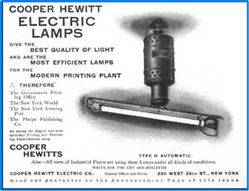

Problem
While the advent of the CFL was a great help to growing in small spaces, it was not without its own problems. The most severe of these was the physical shape of the tube itself. The standard CFL was designed to evenly disperse light in all directions while staying as compact as possible. As such, the tubes were laid out in a circular pattern and often folded back on them selves.
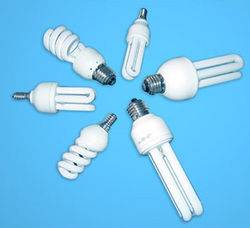
This was fine when trying to simulate a standard incandescent bulb lighting up a room, but did little for the directional needs of a grow space. If viewed from an end, its easy to see just how much light is actually lost. Even with a good reflector added, little is accomplished.
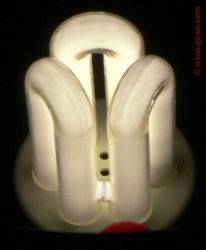

This was fine when trying to simulate a standard incandescent bulb lighting up a room, but did little for the directional needs of a grow space. If viewed from an end, its easy to see just how much light is actually lost. Even with a good reflector added, little is accomplished.

The Alternative
Thanks to “Lights of America” and their recently released R-40 #2948 Floodlight, things are looking brighter for many pot growers. This new bulb is designed to function as an indoor floodlight and has its own built in reflector, but, for just $4.00 and 30 seconds with a screwdriver you can now have an excellent grow-light that will either work on its own or supplement your existing lighting.
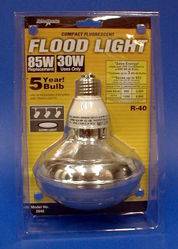
Unlike other CFLs, the tube pattern is wide and flat presenting more surface area and available light in the primary direction. Whatever light is projected to the rear is reversed with the bulbs own integral reflector.

Unlike other CFLs, the tube pattern is wide and flat presenting more surface area and available light in the primary direction. Whatever light is projected to the rear is reversed with the bulbs own integral reflector.
Modifying The Bulb
As it comes, the bulb not only has a reflector, but it also has a built in diffuser. It helps to even and disperse the light when used it its normal configuration. It also tends to block a good deal of the available light. For our purposes, we want all of the light and we want it very directional. This is easily accomplished by simply removing the plastic diffuser. To do so, simply use a fine flat bladed screwdriver and carefully insert it in the groove between the reflector and the diffuser.
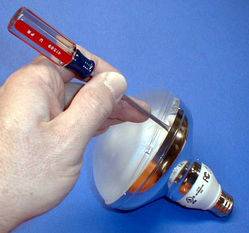
Go slowly and work your way around. You are opening a seam that is held together with flexible glue much like silicon tub sealer. Once the cap is off, just remove any large pieces of sealer left behind and you’re good to go.
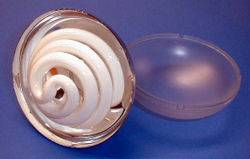
The only other thing that ‘s needed to make this into a functional grow-light is either a hanging lamp socket or rigid base. Both of which can be found in almost any Dollar Store. It can be easily installed a horizontal position, but in most cases you’ll want to go vertical.
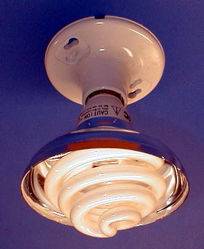

Go slowly and work your way around. You are opening a seam that is held together with flexible glue much like silicon tub sealer. Once the cap is off, just remove any large pieces of sealer left behind and you’re good to go.

The only other thing that ‘s needed to make this into a functional grow-light is either a hanging lamp socket or rigid base. Both of which can be found in almost any Dollar Store. It can be easily installed a horizontal position, but in most cases you’ll want to go vertical.

Conclusion
So, is this the light to end all lights? Will it grow colas the size of Pringle cans and penetrate 24 inches thru a dense canopy? No and no. However it may well be the best light built yet to help out in small grows while providing supplemental lighting in special situations. The bulb itself is tricky to find, but it’s worth the extra effort. When you are growing with multiple 1000 watters, if you loose a drop of light its no big thing. However, with the limited amount of light we have available to use in our smaller environments, every lumen is precious. So quit your browsing and go take a chance. What have you got to loose besides four or five dollars and a few minutes? You might just be pleasantly surprised!
Footnote
* 50 Simple Things You Can Do to Save the Earth, Consumer Guide to Home Energy Savings, The Green Consumer
Last edited:


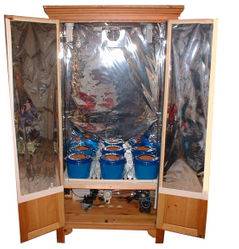
 Also very informative. K+
Also very informative. K+

